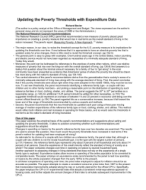Updating the Poverty Thresholds with Expenditure Data
Updating the Poverty Thresholds with Expenditure Data
Abstract
This paper explores the empirical basis of the panel's recommendations and suggestions about setting and updating the poverty thresholds. It takes no position concerning whether such recommendations and suggestions should be adopted.
Changes in spending on basics by the panel's reference family type over two decades are examined. The results are used to answer the question, How much would the poverty thresholds have increased in real terms if the panel's method for updating had been employed all along?
As rationale for its choice of a couple with two children as a reference family, the panel notes that, although a couple with two children is not the modal household type, it is the type with the largest number of persons. (p.101) However, the reference family type represents only about 9 percent of all households and only about 14 percent of all persons. Does the experience of this small minority reflect the standard of living of society as a whole? The paper compares changes over time in spending on basics by several household types.
Another approach to assessing changes in living standards that does not rely on the experience of a single family type is explored. Equivalence scales allow income or spending of the entire population to be converted to comparable levels. The paper employs an equivalence scale recommended by the panel to test how spending on basics by the whole population changed from the early 1970s to the present.
In all these comparisons of spending over time, the price index employed to adjust for inflation should be as accurate as possible. The paper attempts to create a consistent consumer price index from 1967 to the present that incorporates improvements adopted along the way or currently planned for the official CPI-U. Specifically, the paper employs the CPI-U-X1 experimental index that adopts a consistent rental-equivalence approach to housing costs, and further adjusts the annual changes of that index to simulate subsequent improvements in the CPI-U.
The official poverty thresholds have been updated by the official CPI-U. To the extent that the official index overstated inflation, the official poverty thresholds did too. The paper estimates how much the official poverty thresholds have increased in real terms if the alternative price index described above is regarded as a more accurate inflation measure.
Finally, the paper compares proportional increases in spending on basics by the reference family type and the whole population to the proportional increase in the official poverty thresholds. Since the early 1970s, it appears that spending on basics by the reference family and by the population as a whole has increased only slightly more than the real increase in the official poverty thresholds caused by overstatement of the effects of inflation.
Others in Series
Working Paper
Working Paper
Working Paper




